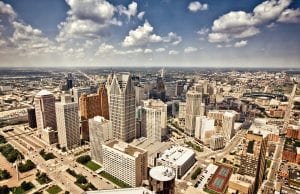
The 5 Things that Drove Expansion in the 1800s
July 9, 2020
A Look at “Jim Crow” America
July 31, 2020The United States population has constantly shifted in a number of ways over the past two centuries.
The sheer number of people who live here has steadily grown but not necessarily in a consistent pattern. Some eras have seen larger increases than others. Right now is not one of those times.
Where people live has changed quite dramatically, too. As the nation expanded, some states became popular destinations while others decreased. The same story with our towns. Some cities have always been among our most populated while others have declined from their heydays and others rocketed up during the latter decades of the 20th century.
The ethnicity of the population is also changing. People of European descent have dominated the population for much of U.S. history, but that is now being altered in dramatic fashion.
Here’s a look at U.S. population trends over the past 230 years.
—————————————-
The first census was taken in 1790, just seven years after the Revolutionary War ended and one year after the U.S. Constitution was ratified.
At that time, the United States basically consisted of the land between the Mississippi River and the Atlantic Ocean. There were the 13 original colonies as well as the Northwest Territory that would later become Ohio, Indiana, Illinois, Michigan and Wisconsin. Spain occupied most of the land between the Mississippi River and the Pacific Ocean as well as what is now Florida.
At the time, the United States had slightly less than 4 million people. About 95 percent of them lived in rural areas and 5 percent resided in urban areas.

New York City has been the most populous city in the United States since the first census in 1790
The most populous state was Virginia followed by Pennsylvania and North Carolina.
New York City was, as it is now, the country’s most populous city with all of 35,000 people. It was followed by Philadelphia and Boston. Charleston, South Carolina, was actually fourth and Baltimore was fifth.
In the 1790 census, there were only three categories of ethnicity – free whites, all other free people and slaves. Those classifications remained pretty much the same until 1860.
————————————————
The United States had a growth spurt between 1790 and 1800 as Vermont, Kentucky and Tennessee were added as states and other regions grew.
The population rose to 5.3 million, a 35 percent increase over 10 years. People still lived in the countryside with 94 percent designated as rural residents and 6 percent as urban dwellers.
Virginia was still the most populous state. Pennsylvania was still second, but New York had climbed into third place.
New York City and Philadelphia remained the two most populous cities, but Baltimore had leaped over Boston and Charleston into third place.
———————————————–
Between 1800 and 1810, the United States reached an agreement with France to acquire a huge chunk of land known as the Louisiana Purchase. The acquisition totaled 828,000 square miles, doubling the size of the young nation.
All or part of 15 states would eventually be carved from this swath of territory between the Mississippi River and the Rocky Mountains.
The new region helped boost the U.S. population to 7.2 million, a 36 percent increase from 1800. The populace was still about 92 percent rural. Among the 7 million people were 1 million slaves.
New York overtook Virginia as the most populous state with nearly 1 million residents. Part of the reason is that Virginia lost some of its territory when Kentucky became a state. Virginia was still second, followed by Pennsylvania and North Carolina.
The order of the cities remained much the same with the noteworthy exception of the growing city of New Orleans, which was the nation’s seventh largest city with 17,000 residents.
——————————————————-
Fast forward to 1830.
The country’s demographics and location of its citizens was slowly changing.
The U.S. population had grown to almost 13 million, rising 33 percent in each of the previous two decades.
The number of slaves almost doubled to 2 million despite the fact the importation of slaves had been prohibited since 1808. The increase is attributed to the fact that children of enslaved people in the United States automatically became slaves at birth.
New York remained the most populous state while Pennsylvania overtook Virginia for second place. The Northwest Territory began to settle, pushing Ohio into the number four slot.
As for cities, the burgeoning seaport of Baltimore edged past Philadelphia into second. New Orleans continued to prosper, sliding into fifth place. And the bustling city of Cincinnati along the Ohio River found itself in eighth place.
Up until 1830, the country experienced a high birth rate, mostly from farmers who had big families with lots of children who could help work the land. After 1830, the birth rate began to decline and immigration started to become a major factor in population growth.
———————————————–
By 1850, the shift was becoming clearer.
The nation’s population had risen sharply to more than 23 million, expanding more than 30 percent in each of the previous two decades. Among the populace were more than 3 million slaves.
With the Industrial Revolution starting to take hold, the percentage of rural residents fell below 85 percent.

Cincinnati, Ohio, was the sixth most populous city in the country in 1850
Ohio continued to grow, slipping past Virginia into third place among the states. Another Northwest Territory state, Indiana, moved past Massachusetts into fifth place.
Cincinnati edged up to the sixth most populous city. The burgeoning city of St. Louis charged into eighth place with its 88,000 residents.
————————————————-
The 1870 census was the first one taken after the end of the Civil War.
After rising another 35 percent in the 1850s, the U.S. population growth slowed to 22 percent in the 1860s. As 1870 dawned, more than 38 million people lived in the country, which included all of what we now call the contiguous United States.
There were 37 states and, for the first time in census history, there were officially zero slaves. Slightly more than 5 million “free black” citizens were counted, up from the 490,000 “free blacks” registered in the 1860 census.
The slow migration to the cities continued as the percentage of rural residents dropped to 74 percent.
New York, Pennsylvania and Ohio retained their spots as the most populous states. However, Illinois and Missouri both grew rapidly, surging into fourth and fifth place.
Among the cities, the new borough of Brooklyn was now the third largest city and St. Louis had vaulted into fourth. The fast growing city of Chicago was now fifth.
San Francisco, buoyed by the 1850s Gold Rush, became the first western city to crack the top 10. Right behind was Buffalo, which had benefited from the completion of the Erie Canal in 1825.
The census labeled 87 percent of the country as “white” and 13 percent as “black.” In that era, “white” included a lot more ethnicities than it does today.
———————————————-
By 1900, the U.S. population reached 76 million, double what it was in 1870. However, the growth rate, driven primarily by immigration, had slowed to 30 percent or less for each of those three decades.
The percentage of rural residents had fallen to 60 percent.
The major news among the states was that Illinois had leapfrogged into third place. A surging Texas had moved into sixth place.
Chicago had also grown rapidly and was now the second most populous city. Cleveland, bolstered by the railroads and shipping traffic on Lake Erie, had rocketed up to seventh.
———————————————
In 1920, the country reached a milestone.
For the first time, more people lived in cities than in rural regions. The census listed urban dwellers at 51 percent that year.
The nation had chugged along with a 21 percent growth rate, entering the Roaring 20s with 106 million people.
The top four most populous states remained the same while Texas edged up to number five. Michigan, boosted by the new auto industry, moved up to seventh while California leapt to eighth.
Detroit, booming from its automobile companies, was now the fourth most populous city. Cleveland climbed into fifth, pushing St. Louis down to sixth. Los Angeles made its first foray into the top 10, landing at number nine. Right behind it was Pittsburgh, expanding along with its steel industry.
Cities in the North, Midwest, and West also benefitted from The Great Migration, which began during the production years of World War One and lasted until almost 1970. During that time, 6 million Black Americans left the segregation and unequal economic opportunities in the South and moved to places in other regions where there were jobs in factories and shipyards.
———————————————-
The Great Depression and World War Two slowed the U.S. growth rate to about 15 percent per decade over the next 30 years.
The country entered the 1950s with a population of 161 million. Of them, 64 percent were listed as urban residents with 36 percent in rural areas.
New York still held its position as the most populous state, but California had vaulted to the number two spot. Florida had finally cracked the top 20.
Among the cities, Los Angeles had moved up rapidly to the fourth spot.
————————————————–
Change was apparent as we hit 1970.
The nation remained at a 15 percent growth rate, reaching 213 million as the 1960s ended. More than 73 percent of people now lived in urban regions,
California surpassed New York as the most populous state. Texas had moved up to number four, just behind Pennsylvania. Florida had skyrocketed to the ninth spot.
New York City and Chicago remained the two most populous cities while Los Angeles had climbed to number three, pushing Philadelphia to fourth. Detroit hung on as the number five city while Houston had zoomed up to number six. Dallas had surged to number eight. The Navy town of San Diego had quietly moved up to 14th place.
——————————————————
Over the next 30 years, the decline of American industry in the Rust Belt became apparent.
As 2000 dawned, the country’s growth rate glided along at slightly more than 10 percent. Now, 81 percent of the country’s 290 million people lived in urban regions, compared to 19 percent of rural residents. About 75 percent of the nation was listed as white.
California lengthened its lead as the most populous state as Texas slipped past New York into second place. Florida moved up to fourth. Georgia was now the 10th largest state.
Los Angeles moved ahead of Chicago as the second most populous city. A number of Sun Belt cities also made their move while some of the country’s better-known industrial cities sank. Houston was now the fourth most populous city while Phoenix moved into sixth. Two Texas cities, Dallas and San Antonio, were now eighth and ninth. Detroit had fallen to 10th place.
———————————————————–
The trend continued over the next two decades.
The population for 2024 is listed as nearly 335 million, the third most populous country in the world. Our population growth is slowing, however. It’s been under 1 percent since 2010. In fact, the Census Bureau reported that the nation’s population grew 0.1 percent in 2021, the lowest rate in our history. It was the first time since 1937 that the population increased by less than 1 million people. Some of the factors are the decline in birth rates, a decrease in immigration and an increased death rate due to the COVID-19 pandemic. The country’s population did rise by 1.7 million in 2023, an increase of 0.53 percent.
The urban population is now at 83 percent, leaving only 17 percent living in rural areas. That’s compared to 49 percent a century ago.
The number of adults who have never been married is at a historic high while the number of two-parent households is declining.
Our median age is now more than 38. That’s an increase of more than 3 years since 2000. Millennials will soon overtake Baby Boomers as the largest adult population in the country. This generation will also change the nation’s demographics as 43 percent of Millennials are non-white.
The population is listed as 59 percent white, 19 percent Hispanic or Latino, 13 percent Black or African-American and 6 percent Asian. Immigration is changing the demographics. Nearly 14 percent of the U.S. population is now foreign-born, the highest percentage in a century. Most are coming from Asia and Latin America. It’s predicted that by 2055, no ethnic group will have a majority in the United States.
The growth in the population has been different in different parts of the country. Since 1940, the South and the West have grown at a quicker pace than the North and the East. In 2018, it was reported that 13 of the 14 states that recorded population growth rates of more than 1 percent were in the South and the West. In addition, nine states from slower growing regions have lost population.
Part of the reason for the geographic shift is the ease of travel with advances in automobiles, roads and planes. The evolution of air conditioning has also made places such as Houston and Phoenix livable.
California and Texas are still the top two states in population, but Florida has now moved up to third, pushing New York to fourth and Pennsylvania to fifth. They’re followed by Illinois, Ohio, and Georgia. North Carolina and Michigan round out the top 10. Virginia, once the country’s most populous state, is now 12th.
The cities have shifted even more. None of the once-mighty Rust Belt industrial cities is in the top 20. Texas has five in the top 11 while California has three in the top 14. New York, Los Angeles, Chicago, and Houston remain the four most populous. Phoenix is now fifth, followed by Philadelphia and then San Antonio. San Diego is eighth, Dallas is ninth and Fort Worth is 10th.

Detroit, Michigan, was the 10th most populous city 20 years ago. It’s now 27th.
Detroit, the 10th most populous city 20 years ago, is now 26th.
Baltimore, once the nation’s second largest city, is now 30th.
New Orleans, after losing more than half its population to the after-effects of Hurricane Katrina in 2005, has started to rebound, but it’s still in 54th place.
Cleveland, which was the fifth most populous city a century ago, is now 55th.
Cincinnati, a top 10 city as the 1900s began, is now the country’s 67th most populous, just behind the new town of North Las Vegas in Nevada.
Pittsburgh, which is reinventing itself after its steel industry collapsed, is now in 72nd place behind St. Paul, Minnesota.
And remember Buffalo? The bustling city on Lake Erie that used hydroelectric power from Niagara Falls to become one of the country’s most electrified cities at the turn of the 20th century?
It’s now in 80th place behind Reno, Nevada, as well as Anchorage, Alaska, and the San Diego suburb of Chula Vista.


